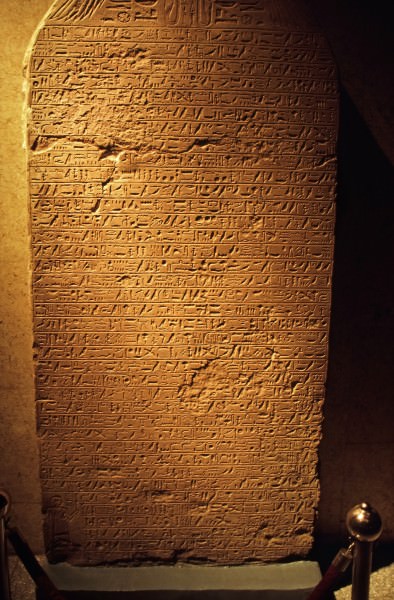Fayum › Second Intermediate Period of Egypt » Ancient origins
Articles and Definitions › Contents
- Fayum › Ancient History
- Second Intermediate Period of Egypt › Antique Origins
Ancient civilizations › Historical and archaeological sites
Fayum › Ancient History
Definition and Origins
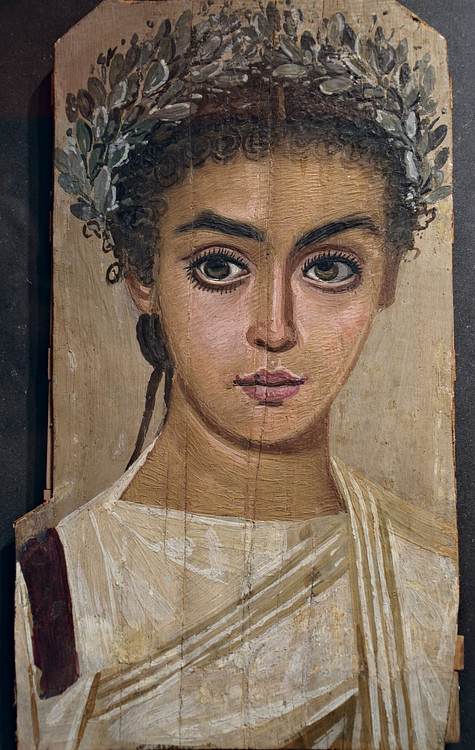
The Faiyum (also given as Fayoum, Fayum, and Faiyum Oasis) was a region of ancient Egypt known for its fertility and the abundance of plant and animal life. Located 62 miles (100 kilometers) south of Memphis (modern Cairo), the Faiyum was once an arid desert basin which became a lush oasis when a branch of the Nile River silted up and diverted water to it. The basin filled, attracting wildlife and encouraging plant growth, which then drew human beings to the area at some point prior to c. 7200 BCE.
In the present day, Faiyum refers to the modern city of Medinet el-Faiyum but, in antiquity, designated the entire area which supported a number of large and quite prosperous villages and cities such as Shedet (better known as Crocodilopolis), Karanis, Hawara, and Kahun, among others. The name derives from the ancient Egyptian word Pa-yuum or Pa-yom meaning “the Lake” or “the Sea” and refers to Lake Moeris, created by Amenemhat I (c.1991-1962 BCE) of the 12th Dynasty during the Middle Kingdom (2040-1782 BCE) when the kings of the 12th Dynasty, in particular, paid special attention to it.
The Middle Kingdom of ancient Egypt is considered a “golden age” in which the culture produced some of its finest works and the Faiyum benefited from the stable rule of the 12th Dynasty as much as any other region and, in many aspects, more so.Although some modern writers and commentators connect Pa-yom with the city of Pithom mentioned in the Book of Exodus 1:11, this claim is untenable; Pa-yom referenced an area, not a city, and the two words are not synonymous.
THE REGION IS BEST KNOWN TODAY FOR THE SO-CALLED FAIYUM PORTRAITS, A COLLECTION OF BEAUTIFULLY RENDERED MUMMY MASKS.
The region was most prosperous during the Middle Kingdom but declined after the fall of the New Kingdom (c. 1570-c.1069 BCE). It experienced a revival during the Ptolemaic Dynasty (323-30 BCE) and the Roman Period (30 BCE-646 CE) after which it was neglected and declined steadily. It is best known today for the so-called Faiyum Portraits, a collection of beautifully rendered mummy masks created during these later periods and unearthed c.1898-1899 CE by the Egyptologist Flinders Petrie.
EARLY HABITATION
Initially a lifeless basin, the Faiyum was transformed into a fertile garden by the natural silting of the Nile which diverted a significant branch of freshwater in its direction. The flow of the water carried with it the rich soil of the Nile River bed which settled in and around the newly-created lake and sprouted vegetation along its banks. The water and plant life attracted animals who made it their home and these then brought others in search of prey or simply creatures seeking water in an arid region.
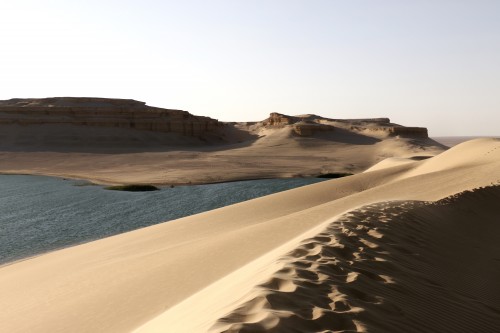
Faiyum
This branch of the Nile would eventually be named Bahr Yusef (“Joseph's River”) in honor of the prophet Joseph in the Quran (the biblical counterpart of the Joseph from the Book of Genesis) and still exists in the present day as a canal. The first canal (known as Mer-Wer, “Great Canal”) was built during the Middle Kingdom. These developments came much later, however, after people arrived and felt the need to name objects and items around them; before it became a canal or had a name it was just a naturally occurring offshoot of the Nile. This waterway, and the fertile environment for wildlife it created, eventually drew human beings to the area.
Evidence of human habitation in the Sahara Desert region dates back to c. 8000 BCE and these people migrated toward the Nile River Valley. According to Egyptologist David P. Silverman, “traces of the earliest undisputed farming community in Egypt have been discovered at Merimde Beni Salama, a site on the western fringe of the Delta dating to c. 4750 BCE” (58). This date was accepted by the scholarly community for decades until, in 2007 CE, the ruins of an older farming community was discovered in the Faiyum dating to c. 5200 BCE and pottery has also been found dating to 5500 BCE. It should be noted that these dates relate only to established agrarian communities, not to human habitation of the Faiyum region which dates to c.7200 BCE.
The Faiyum c. 5000 BCE was a lush paradise in which the people must have lived fairly comfortable lives. There was an abundance of food and water, shade from the sun through the tall fronds of many trees, and fish and wildlife to supplement their diet. At some point around 4000 BCE, however, a drought seems to have changed these ideal living conditions and many people migrated toward the Nile River Valley and left the Faiyum basin relatively deserted. These people would form the communities which grew into the great Egyptian cities of antiquity.
PEAK PROSPERITY
In the Early Dynastic Period (c. 3150-c.2613 BCE) the region seems to have been largely neglected by these settlements, though it was still inhabited, but in the period of the Old Kingdom (c.2613-2181 BCE) the Faiyum was again a lush and wild paradise and became the preferred locale for hunting of wild animals by the Egyptian nobility. At this time, the Faiyum was known as Ta-She (“Land of the Lakes” or “Land of the Southern Lakes”) by the kings of Memphis who recorded their expeditions there.
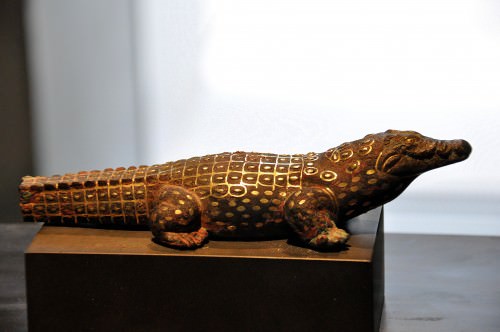
Crocodile Statue from Ancient Egypt
It was a region primarily inhabited by wildlife (though there were still sporadic villages there) and numerous plants, including papyrus, grew in abundance. This was noted by the hunters who soon developed a system to harvest these plants for a number of different purposes. Papyrus is well known as the “paper” of ancient Egypt but was also used for making small fishing boats, rope, clothing, children's toys, amulets, baskets, mats, window shades, as a food source, and for many other items.
In the early Middle Kingdom, Amenemhat I ordered the construction of canal work along the Bahr Yusef which flooded the Faiyum and created the great Lake Moeris. This lake could be the one referenced in the New Kingdom literary work known as Setna II in which a great Egyptian sage defeats a Nubian sorcerer by transporting his diabolical creation to the center of a large lake. Amenemhat I's successor, Senusret I (c.1971-1926 BCE), seems to have felt the lake was too great a luxury and wasted prime agricultural land and so ordered a series of canals built to drain it.
Senusret I's canal system operated off a series of hydraulics which moved the water out of the Faiyum basin to other locales while still preserving a body of water there. The result was a reclamation of fertile land, the transport of water to areas in need of irrigation, and a continuation of the eco-system the lake sustained. Senusret I was succeeded by Amenemhat II (c.1929-1895 BCE) about whose reign little is known but this king's successor, Senusret II (c.1897-1878 BCE) continued Senusret I's policies in the Faiyum and maintained the canal system.
Senusret II was succeeded by his son Senusret III (c.1878-1860 BCE), considered the greatest king of the already impressive 12th Dynasty. Senusret III is best known for his successive victories over the Nubians and the redistricting of Egypt to cut the power of the district governors (nomarchs) but these achievements were only two aspects of a reign which epitomized the Egyptian cultural value of ma'at (harmony and balance) and elevated the Middle Kingdom to its greatest heights. Senusret III's reign marked the peak of prosperity for the Middle Kingdom generally and the Faiyum specifically.
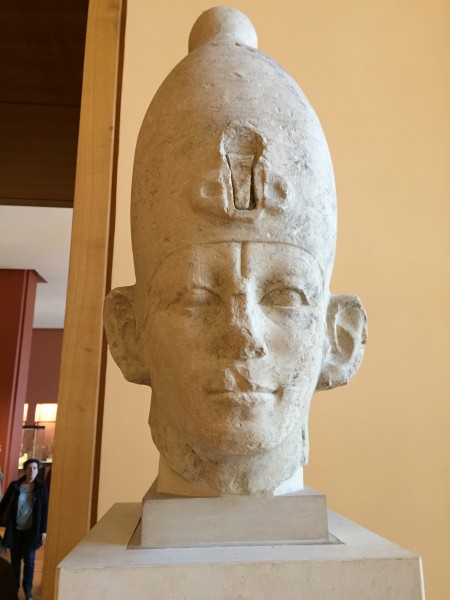
Senusret III
Cities in the Faiyum, such as Kahun (founded by Senusret II) expanded and became more prosperous under Senusret III. The city of Shedet, which was the capital of Faiyum region from the Old Kingdom onward, also thrived as did the others. The rich produce of the region, which reportedly was better tasting than any other, resulted in a high demand and lucrative trade with other regions in Egypt and also abroad.
Senusret III's successor was Amenemhat III (c.1860-1815 BCE) who devoted significant attention to the region. He returned to the policies of Senusret I and installed retaining walls, dikes, and canals to lower the level of Lake Moeris further and provide more arable land. He built the famous Labyrinth as part of his temple complex at Hawara which Herodotus would later record as more impressive than any of the Seven Wonders of the Ancient World. Amenemhat III also erected a number of other remarkable monuments throughout the area, as the kings of the 12th Dynasty had done before him, and instituted policies which stimulated the economy further and encouraged trade.
By this time, of course, the Faiyum was no longer roaming with wild animals or as lush with verdant plant life. As the region became more prosperous, it naturally became more popular; the villages grew into cities and the cities expanded and supported suburbs which grew up on their outskirts and expanded further. Building an addition to one's house, or erecting new homes, was as simple as measuring out a plot of land, making as many mud bricks as were required, and setting them in place. There were no zoning laws and one could build where one pleased as long as no one else objected.
THE GREAT WEALTH OF THE FAIYUM, AS WELL AS ITS NATURAL BEAUTY, ATTRACTED MORE & MORE PEOPLE TO THE REGION EVEN THOUGH THE TAX WAS HIGHER THAN ANYWHERE ELSE IN THE AREA.
There were upper-class homes which featured wooden beams, windows, and wooden doors but the simplest of homes could be constructed for a modest sum and relatively quickly. In the same way that people today ask friends and family to help them move or complete home improvements, those in the ancient Faiyum would host a party where guests would help them make and later assemble mud bricks to build a home or addition. The great wealth of the Faiyum, as well as its natural beauty, attracted more and more people to the region even though the tax the government levied on these citizens was higher than anywhere else in the area.
This was the state of the Faiyum region at the beginning of the 13th Dynasty of the Middle Kingdom. The 13th dynasty lacked the power and focus of the 12th and slowly degenerated with each successive ruler. Towards the end, the nobility was focused far more on their own pleasure and personal dramas than the good of the country and allowed the Hyksos, a foreign people who had established themselves at Avaris in the Delta, to gain significant control over Lower Egypt. These developments led to the steady loss of power of the central government which finally fell, ushering in the era known as the Second Intermediate Period (c.1782-c.1570 BCE).
Little is recorded of the Faiyum during this time or in the New Kingdom which followed it. No new monuments were built and maintenance of the canals seems to have been neglected. By the beginning of the Ptolemaic Dynasty, the great canals, hydraulic works, walls, and monuments had suffered from years of inattention and the Faiyum was only a pale shadow of its former self.
THE GRECO-ROMAN PERIOD & FAIYUM PORTRAITS
The Third Intermediate Period (c.1069-525 BCE), which followed the New Kingdom saw an Egypt divided in rule between Tanis and Thebes, rulers from Libya and Nubia, and was punctuated at the end by the Persian Invasion. The Late Period (525-332 BCE) was an era in which the country traded hands between the Persians and Egyptians until the Persians conquered the country. Alexander the Great took Egypt from the Persians in 332 BCE and, after his death, it was claimed by one of his generals, Ptolemy I Soter (323-285 BCE), who founded the Ptolemaic Dynasty.
Ptolemy I and his immediate successor, Ptolemy II Philadelphus (285-246 BCE) devoted significant attention to the Faiyum, repairing and renovating the monuments, temples, canals, and administrative buildings which had fallen into decay. Ptolemy I drained Lake Moeris further for more arable land and Ptolemy II allocated lots of this fertile region to Greek and Macedonian veterans who improved upon it.
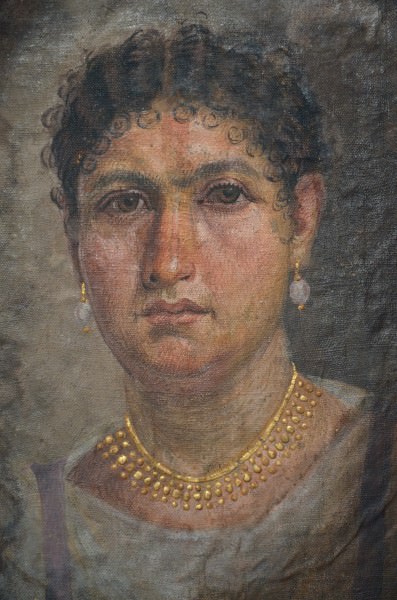
Mummy portrait of Lady Aline
Since the conquest of Alexander the Great in 332 BCE, life in the Faiyum had improved dramatically. Although evidence of this prosperity is seen in a number of examples, the best and most famous is the Faiyum Portraits. These are paintings of the elite members of the community produced on wooden panels and placed on their mummies.
When they were first discovered by Flinders Petrie in the late 19th century CE it was thought they were painted from life and the subjects kept them on the walls of their homes until their deaths. It has since been established, however, that these paintings were done after the subjects' death. The incredible vitality of the paintings, especially the expressive eyes, makes it easy to understand why Flinders Petrie believed the subjects had to have been alive when the paintings were done.
These works are detailed renderings which accurately depict the clothing, jewelry, hair styles, and important personal objects of people at the time. The obvious wealth of the subjects reflects the prosperity of the region which is also exemplified simply by the existence of the paintings which are high-quality works created by an affluent and stable society. Egyptologist HelenStrudwick writes:
The Faiyum Portraits are truly original pieces of art, representing a synthesis of the naturalistic Classical style of portraiture with the ancient Egyptian concept of death as a gateway to a continuing existence in the afterlife. The portraits have provided Egyptologists with a wealth of information regarding high-status members of Greco-Roman society in Egypt – in particular their clothing, adornment, and physical characteristics – as well as being masterpieces of art in their own right. (336)
The paintings reflect the attention which was once again lavished on the Faiyum during this time. The first two rulers of the Ptolemaic Dynasty drew on inspiration from Egypt's past and worked to create a multi-cultural society which welcomed diversity and encouraged culture and intellectual pursuits. It was under these rulers that the Library at Alexandria, the Serapeum, and the great lighthouse at Alexandria were all created. Their successors were less competent however and, by the time of Cleopatra VII (c.69-30 BCE) the grandeur of Egypt had waned considerably.
DECLINE OF THE FAIYUM
After Cleopatra ’s death, the country was annexed by Rome under Augustus Caesar (27 BCE-14 CE). By this time, after the years of neglect during the later Ptolemaic Dynasty, the Faiyum had deteriorated to the point where the canals and drainage pipes were blocked and unusable. Augustus ordered extensive repairs to the area on every level and brought the Faiyum back to life. Throughout the early years of the Roman Period the area experienced something of its former prosperity since it was still such fertile farm land and Egypt was considered Rome's breadbasket, furnishing the empire with grain.
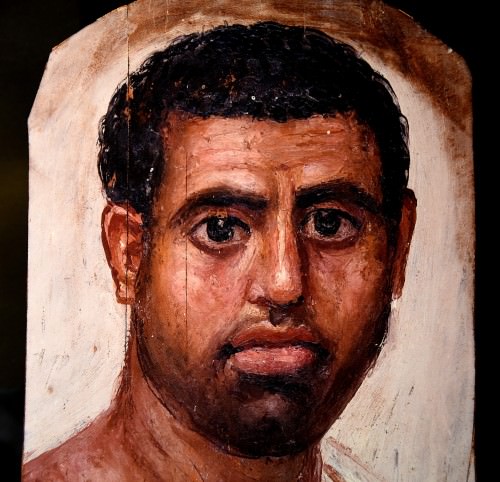
Mummy Portrait of a Man from Fayum
The Faiyum continued to prosper as long as the empire was stable and expanding on a steady, regular, basis but, when it began to decline, its provinces followed suit. The Faiyum's population began declining in the 2nd century CE and a deadly plague devastated the population further. By the beginning of the 3rd century CE the population had been reduced to below 10 percent of the previous century's occupants.
The fertile valley, by this time, had been overused and much of the land had been developed to the point where there was no longer any wild game to hunt and no new wildlife came to the area. The papyrus plants, which had once been so plentiful, had been harvested to near extinction as had the flowers and other fauna which had once attracted the people to the region in the first place.
Although the Faiyum continued on throughout the Roman Period until the Arab Invasion of the 7th century CE, and served as the center of Egyptian resistance to the Arabs, it would never return to its former grandeur and prosperity. Under Arab rule it would certainly experience eras of abundant crops and prosperous trade, and the population again expanded, but the natural resources of the region had been depleted – and would continue to be as more and more was asked of the land – until the valley again resembled the arid basin it had been millennia before.
In the present day, the area is again a rich agricultural region due to ecological preservation efforts and improvements in land husbandry. A number of impressive ancient Egyptian ruins have also been preserved throughout the region, such as the pyramid of Amenemhat III at Hawara, but even though the area is relatively close to Cairo it does not receive many tourists.The people of the Faiyum today live largely as their ancestors did thousands of years ago as they farm the land with essentially the same kinds of tools, and in the same way, as the people did long ago in the golden age of the Middle Kingdom.
Second Intermediate Period of Egypt › Antique Origins
Definition and Origins
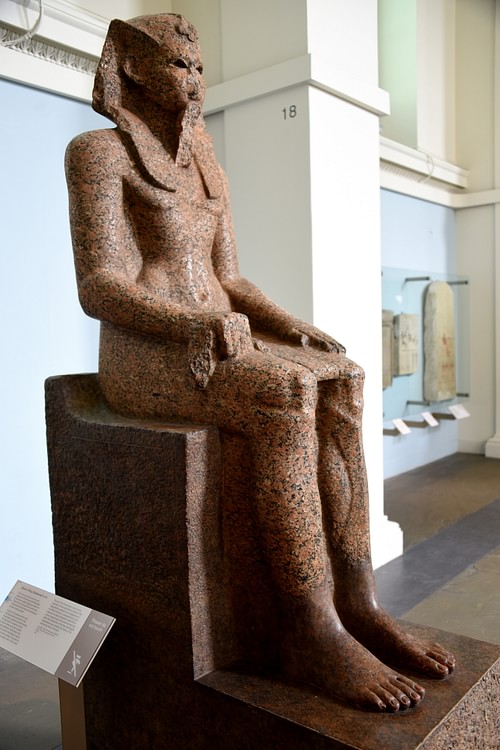
The Second Intermediate Period (c. 1782 - c.1570 BCE) is the era following the time of the Middle Kingdom of Egypt(2040-1782 BCE) and preceding the New Kingdom (1570-1069 BCE). As with all historical designations of the eras of Egyptian history, the name 'Second Intermediate Period' was coined by 19th-century CE Egyptologists to demarcate time periods in Egypt 's history; the name was not used by ancient Egyptians. This era is marked by a divided Egypt with the people known as the Hyksos holding power in the north, Egyptian rule at Thebes in the center of the country, and Nubians ruling in the south. As with the First Intermediate Period of Egypt, this time is traditionally characterized as chaotic, lacking in cultural advancements, and lawless, but as with the earlier period, this claim has been discredited. The Second Intermediate Period of Egypt was a time of disunity and records of the time are confused or missing, but it was not as dark a time as later Egyptian writers claimed.
This period begins as the Egyptian rulers of the 13th Dynasty move the capital from Itj-tawi (in Lower Egypt near Lisht, south of Memphis ) back to Thebes, the old capital of the late 11th Dynasty in Upper Egypt, loosening their control over the north. In the beginning of the 12th Dynasty, the king Amenemhat I (1991-1962 BCE) founded the small town of Hutwaret (better known by the Greek name Avaris) in the far north, which grew into a trading center with easy access to the sea and connected by land routes to Sinai and the region of Palestine. In the course of the 13th Dynasty successful trade and immigration brought an influx of Semitic peoples to Avaris who eventually gained enough wealth and power to exert political influence in the country. These people were known to the Egyptians (and themselves) as Heqau-khasut ('Rulers of Foreign Lands') but were called 'Hyksos' by the Greek writers, the name they are known by in history.
The later Egyptian writers depict the Hyksos as brutal conquerors who destroyed Egypt, ransacked the temples, and oppressed the country until it was liberated and unified under the reign of Ahmose of Thebes (c. 1570-1544 BCE).Archaeological evidence and records of the time, however, strongly suggest a very different story. The Hyksos, far from the cruel conquerors of later histories, admired Egyptian culture greatly and adopted it as their own. They lived cordially, if not exactly peacefully, with the government at Thebes until a perceived insult drove the Theban kings to declare war on them and they were driven out. Ahmose I's victory signaled the end of the Second Intermediate Period and the beginning of the New Kingdom.
THE HYKSOS ARRIVAL IN EGYPT
The period is chiefly characterized by the rule of the Hyksos in northern Egypt and, to a lesser but significant degree, the power of the Nubians in the south. The only reason the Nubians do not factor more in defining the time is because the Egyptian records show a continuity in relations with southern lands while the Hyksos were unprecedented and were said to have introduced new concepts and ways of life.
THE IDENTITY OF THE HYKSOS REMAINS UNKNOWN. THEY PROBABLY ARRIVED AT AVARIS VIA OVERLAND TRADE ROUTES FROM SYRIA -PALESTINE, GREW SUCCESSFUL THERE, & ESTABLISHED A SEAT OF POWER ONCE THEY HAD THE WEALTH & ABILITY.
The identity of the Hyksos remains unknown. Many theories have been advanced including that they were refugees fleeing from the Aryan Invasion in Asia. The Aryan Invasion Theory itself has been discredited and so has this claim. They were referred to by the Egyptians as 'Asiatics,' but this was a term used for anyone beyond the eastern border of the country from the Levant to Mesopotamia. The name most commonly used translates as 'Rulers of Foreign Lands,' not 'people of foreign lands,' and so some scholars have advanced the claim they were invaders who landed at Avaris, established a strong center of power, and then conquered the land as far south as Abydos.
This claim is almost wholly based on the writings of the 3rd-century BCE Egyptian historian Manetho. Manetho's work has been lost, but he was quoted extensively by later historians including the Jewish- Roman writer Josephus. Manetho's version of the Hyksos' arrival characterizes them as destructive invaders who destroyed the country:
By main force they easily seized [the country] without striking a blow and, having overpowered the rulers of the land, they then burned our cities ruthlessly, razed to the ground the temples of the gods...Finally, they appointed as king one of the number whose name was Salitis. He had his seat at Memphis, levying tribute from Upper and Lower Egypt and always leaving garrisons behind in the most advantageous positions. (Shaw, 183)
Manetho's report, as given in Josephus, was taken as historical fact by scholars and laymen alike for centuries until the archaeological evidence proved it inaccurate. Excavations at Avaris have revealed a once-thriving port city whose design is non-Egyptian and closely parallels architecture and design from the region of Syria-Palestine. No Hyksos stronghold has been found at Memphis and no record of widespread destruction of the country during the time of the Hyksos. The theory most widely accepted by scholars and Egyptologists today is that the Hyksos arrived at Avaris via overland trade routes from Syria-Palestine, grew successful there in the course of the 12th and early 13th dynasties, and established a seat of power once they had the wealth and ability to do so. There is no evidence at all that the Hyksos suppressed Egyptian religion and culture; in fact, they admired and adopted both.
THE DECLINE OF THE MIDDLE KINGDOM & RISE OF THE HYKSOS
The 12th Dynasty of Egypt during the Middle Kingdom is considered a golden age in the country's history. Literature and the arts flourished, trade and military conquests made Egypt rich, fortified borders provided security, and the kings of the time maintained a stability and encouraged creativity and diversity. It was at the beginning of this period that Avaris was founded, and those who arrived to trade there would have been duly impressed by Egyptian society at the time. However the Hyksos originally came to Egypt, in however many numbers, they would have found it very attractive.
At the time their power was growing at Avaris, the kings of the 13th Dynasty were waning. After the first king of the 13th Dynasty, Sobekhotep I (c. 1802-1800 BCE), the chronology of the 13th Dynasty becomes jumbled and confused, fewer monuments are built, fewer inscriptions made. The precise cause of the dissolution of the 13th Dynasty is not clear. It could have been as simple as the personality of the individual kings who were not as efficient as those of the 12th Dynasty or it could have been any other reason. Although various writers have advanced theories, the lack of records from the time pointing to a specific cause make any claim speculative.
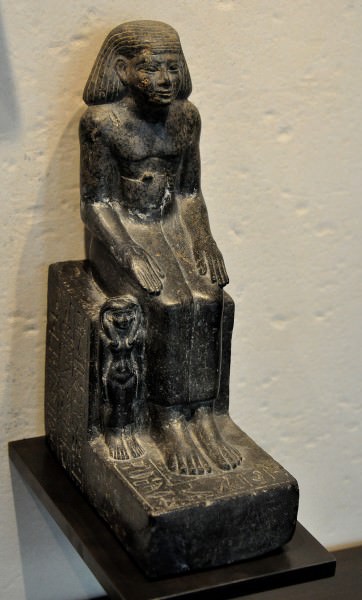
Statue of Sobekhotep
For whatever reason, the Egyptian capital at Itj-tawi faltered and the government then left that city and returned to Thebes.This move effectively left the north, Lower Egypt, open to whatever political powers had the strength to develop there. When the capital had been at Thebes toward the end of the 11th Dynasty it was ruled by a powerful king who commanded respect;this was not the situation c. 1782-1760 BCE when the 13th Dynasty was steadily losing power. When Manetho claims that the Hyksos took the country "without striking a blow," it could be the only part of his report he got right. The Hyksos would not have had to invade the land or burn any cities to seize power. The north of Egypt had more or less been handed to them to do what they wanted with.
THE NUBIAN KINGDOM OF THE SOUTH
King Senusret III (c. 1878-1860 BCE), the most powerful Egyptian ruler of the Middle Kingdom, led numerous expeditions south into Nubia, securing the land and fortifying the borders between the two countries. He garrisoned these forts with Egyptian soldiers, thus sealing the border and regulating immigration. The relationship between Nubia and Egypt at this time seems mutually beneficial according to existing trade documents from these fortifications. The Nubians admired the Egyptian culture and adopted many of their gods and aspects of their culture.
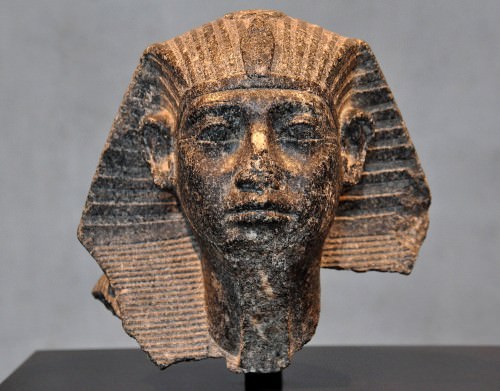
Head of Senusret III
During the latter part of the 13th Dynasty, the Egyptian kings stopped supplying the fortifications at the border and no new troops were stationed there. The soldiers already deployed at the forts were never recalled to Egypt, and the former garrisons became their homes. These soldiers maintained contact with the Egyptian capital at Thebes and the Kingdom of Kush and acted as intermediaries in trade. Historian Marc van de Mieroop notes:
They maintained trade contracts with Egypt. In certain forts were found thousands of sealings - lumps of clay impressed by a scarab - recording the names of 13th-dynasty kings, and even later ones, including some Hyksos. Those sealings were originally attached to sacks and jars with goods imported from Egypt and trade seems to have been intense at least in the early Second Intermediate Period. (136)
As the 13th Dynasty neglected matters to the south, just as they were doing to the north, the Kingdom of Kush developed into a centralized power with their capital at Kerma. The origin of the name of this kingdom is unknown, but it is clear the people referred to themselves as 'Kushites' while Egyptian records called them 'Nubians' from the Egyptian word nub ( gold ) because they associated the region with gold. The early temples and cities of the Kushites show strong Egyptian influence, which gradually diminishes to be replaced by a combination of Nubian (Kushite) and Egyptian styles.
Van de Mieroop observes that "the leaders of this community sought to portray themselves as true kings, queens, and noblemen and looked to Egypt for inspiration" (139). They adopted Egyptian dress, mannerisms, and worshiped Egyptian gods. At some point, some of the old Egyptian fortifications along the border were destroyed, possibly in an attack, although this is uncertain. What is clear is that, as the Egyptian government at Thebes ignored the power of Kush in the south, that power grew and the border became more fluid. The soldiers who had been left behind no longer considered it their responsibility to guard against incursions and, by this time, were more accustomed to the role of merchants than that of military men.
RELATIONS BETWEEN EGYPTIANS, HYKSOS, & NUBIANS
Egypt's situation at this time (c. 1700-1600 BCE) was a divided nation of three central powers, but contrary to the view of 19th and early 20th century CE scholars, it was not a time of chaos or unrest. As noted, trade continued between the Kingdom of Kush and Thebes, between Kush and the Hyksos, and between Thebes and the Hyksos. The Hyksos would sail past Thebes on their way to Kush and the Thebans would travel the Nile to trade with the Hyksos. There seems to have been a kind of truce between Thebes and Avaris, which indicates that the two were not on exactly cordial terms but were far from hostile to each other.
The Hyksos considered themselves legitimate citizens of Egypt worthy to wield power and direct the people's destiny. The kings recorded for the latter part of the 13th-16th Dynasties are non-Egyptians or, at least, do not have Egyptian names and are regarded as Hyksos rulers. Their chronology is confused, and some names are only known through ceremonial objects while others only from fragments of king's lists, so dating them is difficult.
What is clear is that however the 'true Egyptians' at Thebes and the 'foreign kings' at Avaris felt about each other, the two cities were on peaceful terms and there was long-term interaction through trade. Further, neither city interrupted the other's relationship with the Kushites in the south, nor is there any evidence that they interfered with each other's trade or business in other areas. All of this changed shortly before or around the time the 17th Dynasty came to power at Thebes.
THEBES VS. AVARIS
The Egyptian king Seqenenra Taa (also known as Ta'O, c. 1580 BCE) of the 17th Dynasty led an expedition against the Hyksos c. 1560 BCE according to later writers. His mummy, discovered in the cemetery near the Valley of the Kings by Thebes, shows he was most likely killed in battle. He "died violently at an age between 30 and 40 years. He received blows on his head from several axes and his face was cut and smashed" (van de Mieroop, 142). This conflict seems to have arisen in response to an insult, or perceived insult, of Ta'O by the Hyksos king Apepi.
The details of this entire episode are unclear, but it seems that Apepi of Avaris sent a messenger to Ta'O of Thebes relaying a demand, which was taken as a challenge: "Do away with the hippopotamus pool which is on the east of the city, for they prevent me sleeping day and night." Instead of complying with the request, Ta'O marched an army toward Avaris and attacked.Whether his forces were successful is unknown, but this is when he was probably killed in the battle, and the fact that the Hyksos continued on at Avaris following this suggests the Thebans were defeated. Hostilities between the two cities and their people, however, had only just begun.
KAMOSE OF THEBES
Following Ta'O's death, his son Kamose (c. 1575 BCE) ruled at Thebes. He continued the war with the Hyksos citing as his justification the fact that he was a true Egyptian, who should not have to share his country with foreign powers. An inscription from Kamose reads:
To what end do know my own strength? One chief is in Avaris, another in Kush, and I sit here associated with an Asiatic and a Nubian! Each man has his slice in this Egypt and so the land is partitioned with me! See he even has Hermopolis! No one can be at ease when they are milked by the taxes of the Asiatics. I shall grapple with him that I might crush his belly for my desire is to rescue Egypt which the Asiatics have destroyed. (van de Mieroop, 143)Stela of Kamose
Kamose's advisers were against a large-scale military action against the Hyksos, but they were ignored. Kamose marched on Avaris, transporting his army in ships on the Nile and then releasing them on the city, and destroyed it. Kamose writes:
I caught sight of his womenfolk upon his roof, looking out of their windows towards the river-bank, their bodies frozen at the sight of me. They looked out with their noses on their walls, like young mice in their holes, crying, "It is an attack!" (Watterson, 59)
Kamose further claimed that his attack was so swift and merciless that the surviving women became infertile. He also claims to have razed Avaris to the ground and then sailed back to Thebes with his plunder. The Hyksos of Avaris had been destroyed, but they still held the north of Egypt above Memphis. Kamose ruled for approximately three more years during which time he continued his war against the foreign kings and seems to have captured Memphis from them. When he died he was succeeded by his brother Ahmose, founder of the 18th Dynasty and the New Kingdom of Egypt.
AHMOSE I & THE UNIFICATION OF EGYPT
Ahmose I is credited with driving the Hyksos from Egypt and reuniting the country under the central rule of Thebes. Historian Margaret Bunson, drawing on the stele account at Karnak, writes how Ahmose I "ran the Asiatics out of Egypt, pursuing them to Sharuhen and then into Syria" (80). This action does not seem to have been as easily accomplished as some inscriptions and many historians make it seem. The inscription from the tomb of Ahmose mentions a second and third battle at Avaris, indicating that Kamose's boast of destroying the city utterly was either an exaggeration or that the Hyksos rebuilt Avaris.Archaeological evidence would indicate the former and that it was Ahmose I who was responsible for the destruction of Avaris.
In a tomb inscription, another Ahmose (son of Ibana) who was a soldier under Ahmose I, mentions hand-to-hand fighting at Avaris in an initial battle and then two others, equally fierce, before the surviving Hyksos took flight to Sharuhen in the Palestine region. Sharuhen, according to the inscription, had to be laid under siege for six years before it fell, and the survivors then fled to Syria with Ahmose I in pursuit. What happened to them once they reached Syria is not recorded. Most likely, having defeated his enemy and driven them from the field, Ahmose I turned around and went back to Egypt.
Inscriptions from the time and that following show that all political influence of the Hyksos was terminated in Egypt under Ahmose I. Ahmose I then turned his attention to the south and campaigned into Nubia south of the second cataract of the Nile, reclaiming those lands which had been lost. He restored the cities of Egypt, rebuilding and refurbishing temples, and consolidated his power at Thebes following the example of great kings of the past who placed the most power in their closest and most trusted family members.
LEGACY OF THE SECOND INTERMEDIATE PERIOD
As with the other Intermediate Periods of Egypt, the Second is characterized as a time of discord. Scholars Brier and Hoyt provide the popular view of the era when they write how, following the Middle Kingdom, "Egypt entered its second Dark Age" (25). It is true there were some cultural losses such as the ability to write hieroglyphic script. During the Second Intermediate Period, scribes were no longer taught hieroglyphic script and hieratic script (cursive) developed. The quality of the arts also seems to have suffered. Still, the culture endured, developed, and moved forward. Literature was still written and religious rites observed. The Second Intermediate Period, although not as well documented as the Middle Kingdom or the New Kingdom, was far from a dark age.
This claim by noteworthy scholars that the period was a chaotic cultural degeneration is understandable, however, in that the later Egyptian historians and scribes of the New Kingdom portrayed it that way. To these Egyptian writers, the Second Intermediate Period had been a period of weakness and chaos when the underlying principle of life in Egypt, harmony ( ma'at ) had been cast aside by foreign invaders who upset the balance of the land and plunged all into turmoil. Egyptologist Barbara Watterson comments on this:
Hyksos rule in Egypt lasted just over 100 years, not the unmitigated disaster proclaimed by the native historians of later periods, but the catalyst that impelled Egypt into its imperial age, providing it with the incentive for expansion and, more importantly, the means with which to achieve it. The shock of the Hyksos invasion had had a salutary effect upon the Egyptians, who looked upon other nations with scorn. The Egyptian word for "mankind" (rmt) referred only to Egyptians; they spoke of other ethnic groups in derogatory terms - "the vile Kushites", "the wretched Asiatics". The Hyksos had destroyed their age-old sense of security, for the first time bringing home to them that they were not inviolable. (60)
When Watterson mentions "the means with which to achieve" the expansion of the New Kingdom she is referring not only to the renewed sense of nationalism which rose with Ahmose I's defeat of the Hyksos but, more importantly, the innovations and inventions the Hyksos had introduced to Egypt. In the military sphere alone, the Hyksos had given the Egyptians the horse-drawn war chariot - a weapon they never had before - as well as the composite bow, which had greater strength and range than the Egyptian long bow, the bronze dagger, and the short sword.
Further, they introduced the Egyptians to their neighbors in a way never experienced before. Prior to the rise of the Hyksos, people from the Levant or Nubia or Punt were considered by the Egyptians as acceptable as partners in trade but certainly not equal to the Egyptians in any way and hardly worth considering as a serious threat to Egyptian life. The Hyksos showed that another nation could exercise the same power, in the same way, as Egypt and that the Egyptians should revise their earlier opinions of these other people. Watterson writes:
From the Hyksos invasion came the realization that, if a second invasion were to be prevented, a buffer state in western Asia must be created; and in fulfilment of this policy, the early rulers of the Eighteenth Dynasty took the measures that enabled Egypt to embark upon its imperial age. (60)
The legacy of the Second Intermediate Period is the glory which would become the New Kingdom, a time of unprecedented wealth and prosperity in Egypt. The impetus toward securing the country from another invasion by enlarging Egypt's borders and bringing more material wealth into the land through conquest led to the period in Egypt's history which is the best known and most admired. The 18th Dynasty of Egypt, which Ahmose I founded, would create some of the most famous and memorable monuments since the pyramids of the Old Kingdom and enlarge the boundaries of Egypt into an empire.
LICENSE:
Article based on information obtained from these sources:with permission from the Website Ancient History Encyclopedia
Content is available under License Creative Commons: Attribution-NonCommercial-ShareAlike 3.0 Unported. CC-BY-NC-SA License
